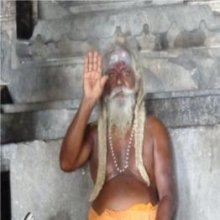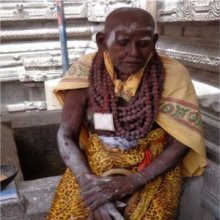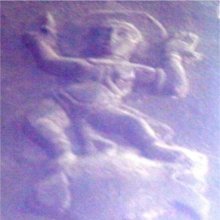Arunachaleshvara, Aruṇāchaleśvara, Arunachaleshwara: 1 definition
Introduction:
Arunachaleshvara means something in the history of ancient India. If you want to know the exact meaning, history, etymology or English translation of this term then check out the descriptions on this page. Add your comment or reference to a book if you want to contribute to this summary article.
Ambiguity: Although Arunachaleshvara has separate glossary definitions below, it also represents an alternative spelling of the word Arunacaleshvara. It further has the optional forms Arunachala-ishvara, Aruṇāchala-īśvara, Aruṇāchaleśvara, Arunachalesvara, Arunachala-ishwara, Arunachala-isvara, Aruṇāchala-īśwara and Arunachala-iswara.
Images (photo gallery)
India history and geography
Source: Shodhganga: The significance of the mūla-beras (history)Arunachaleswara (Aruṇācaleśvara) Temple in Thiruvannamalai (Tiruvaṇṇāmalai) refers to one of the Pañcasabhā or “five halls where Śiva is said to have danced”.—The Śaivite puṇya-sthala (holy place) Aruṇācaleśvar Temple is in Tiruvaṇṇāmalai District. The town stands at an elevation of 266 ft (79.80M) above sea level. According to Narayanaswamy, this sthala is also known by the names Aruṇagiri, Aṇṇāmalai, Aruṇāchalam, Aruṇai, Soṇagiri, and Soṇācalam. All these names signify the Fire Mountain. The very hill called Aṇṇāmalai or the Great Mountain is worshipped as the liṅga. The sthala is famous as it is considered the seat of Jyoti or teyu-liṅga (one of the five sacred liṅgas). The Aruṇācaleśvar Temple is one of the biggest temples in Tamilnadu.
The Aruṇācaleśvar Temple at Tiruvaṇṇāmalai represents the element of Fire.
Architectural details of Arunachaleswara:—The Aruṇācaleśvara (Arunachaleswara) Temple occupies an area of 24 acres and is decorated with magnificent sculptures. The temple is adorned with four towers facing the four directions. The rāja-gopura or the main tower has 11 floors and is 217 feet high. There is a thousand pillared maṇḍapa to the right of the sannidhi (sanctum) of Kambattu Ilayanar, where Lord Murukan is enshrined. [...] There are also the sthala-vṛkṣa (tree of the temple), the kalyāṇa-maṇḍapa (marriage hall of the gods and goddesses) and the yāgaśāla (the hall meant for sacrificial rituals). All the deities of the pañcabhūta-sthalas (temples of the five elements) are installed here. In the second prahāra is the garbhagṛha of Aṇṇāmalai. It is an inspiring sight to see all the five deities mounted on silver vāhanas (vehicles).

The history of India traces the identification of countries, villages, towns and other regions of India, as well as mythology, zoology, royal dynasties, rulers, tribes, local festivities and traditions and regional languages. Ancient India enjoyed religious freedom and encourages the path of Dharma, a concept common to Buddhism, Hinduism, and Jainism.
See also (Relevant definitions)
Partial matches: Ishvara, Arunachala.
Full-text (+4): Ampal, Parvati, Kalyāṇa-Sundareśvara, Arunacaleshvar, Arunachalam, Arunacala, Shiva, Arunacaleshvara, Arunai, Sonagiri, Annamalai, Svarna-Bhairava, Arunagiri, Sonachalam, Sonacala, Venugopala, Ganga, Unnamulai, Gajalakshmi, Dakshinamurti.
Relevant text
Search found 5 books and stories containing Arunachaleshvara, Arunachala-ishvara, Aruṇāchala-īśvara, Aruṇāchaleśvara, Arunachaleshwara, Arunachalesvara, Arunachala-ishwara, Arunachala-isvara, Aruṇāchala-īśwara, Arunachala-iswara, Aruṇāchaleśwara, Arunachaleswara; (plurals include: Arunachaleshvaras, ishvaras, īśvaras, Aruṇāchaleśvaras, Arunachaleshwaras, Arunachalesvaras, ishwaras, isvaras, īśwaras, iswaras, Aruṇāchaleśwaras, Arunachaleswaras). You can also click to the full overview containing English textual excerpts. Below are direct links for the most relevant articles:
Early Chola Temples (by S. R. Balasubrahmanyam)
Temples in Erumbur (28th year) < [Chapter X - Historical Survey]
Temples in Arunachalesvarar (Tiru-Annamalaiyar) < [Chapter X - Historical Survey]
Devakoshta < [Chapter XIII - Prasada: Component Parts]
Bhagavan Ramana and Vasishtha Ganapati Muni < [July – September 1976]
Bhagavan Ramana and Vasishtha Ganapati Muni < [October - December 1976]
Shankaracharya and Ramana Maharshi (study) (by Maithili Vitthal Joshi)
Pallava period (Social and Cultural History) (by S. Krishnamurthy)
Preceptors of Advaita (by T. M. P. Mahadevan)



